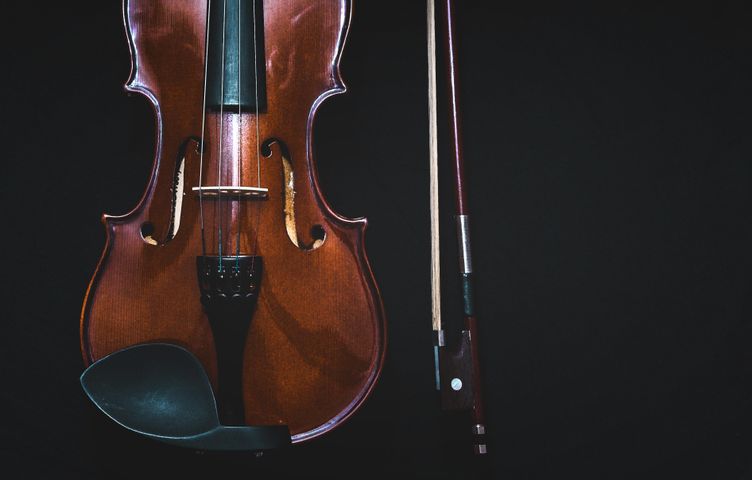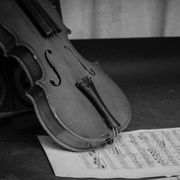
From: https://www.violinist.com/blog/paulinefiddle/200610/5901/
Does playing the violin affect the brain? Most violinists would probably say “yes” in a subjective way, but there is striking objective evidence, too. Perhaps most interesting are the findings that the brain is actually modified physically by studying the violin in ways that make it easier to learn more. The cerebral cortex, the site of higher thinking in the brain, is not a static structure. Its organization changes over time, giving the brain an astonishing ability to adapt to new needs.
Music and spoken language
Broca’s area is a small part of the cortex which handles many tasks of spoken language and musical abilities. The amount of gray matter (neurons) in Broca’s area is larger in musicians than in nonmusicians. In fact, the volume of gray matter in this brain region increases as the number of years of playing increases. In most people, the amount of gray matter in Broca’s area decreases with age, but in musicians, this does not happen.
Pure tones and other tones
Tone perception is localized in some very small, specialized areas of the cortex -- perception of pure tones in one area and tones of various timbre (violin, piano, and trumpet timbre, for example) in other areas. In the brains of trained musicians, the cortical areas corresponding to tones of various timbres are larger than the areas corresponding to pure tones. Violinists have more of their brains devoted to the perception of violin tones. Likewise, trumpeters have more of their brains devoted to the perception of trumpet tones. The enlargement of appropriate areas of the cortex is greater in people who started their music studies at younger ages.
Suzuki kids
If early training in music modifies the structure and organization of the brain, these changes should be seen in the brains of young children. A series of studies was designed to look for these effects in four to five year olds in Suzuki training and nonmusician children of the same age. The investigators measured AEPs (auditory evoked potentials, electrical signals from the brain), which can be measured noninvasively and safely, in response to pure tones, violin tones, and piano tones. The AEPs for all tones were greater in Suzuki kids than in other kids of the same age. The effects were specifically enhanced for the instrument of practice, so that children studying violin had greatest AEPs for violin tones, and piano students had greatest AEPs for piano tones.
Mozart Concerto
What happens inside the brain of a violinist when he plays a piece of music? The brain mobilizes its resources for guiding muscle movements and for thinking/emoting about the music, activities localized in different parts of the cortex. A group of scientists studied the activity of various parts of the cortex in amateur and professional violinists playing the first 16 bars of Mozart’s Violin Concerto in G major. The brains of the professional musicians were more efficient in guiding their muscle movements than the brains of amateur musicians. The professionals’ fingers worked with less mental effort than those of the amateurs. As a result, more of the resources of the professionals’ brains were free to work on the audio effects of their performance.
Why practice?
Suzuki told an interesting anecdote about the mother of a young Suzuki student and her baby. She was listening to some recorded music and holding her baby in her arms, and the baby seemed content. That changed when some music from one of the early Suzuki books came on. The baby became ecstatic, smiling and wriggling his whole body. He obviously recognized the music and liked it. I thought of this story when I read one of Karin Lin’s blogs earlier this year. She said that she was clapping and saying, “Mississippi Hot Dog” with her three year old, a Suzuki student, and her 10 month old baby tried to clap in time and said something like “Huh duh.” I thought that this could be a serious responsibility for a Suzuki parent. What would happen if she played or sang out of tune? Would her child’s sense of pitch be destroyed forever? William Starr, a disciple of Suzuki and a great educator in his own right, recounted a story that addressed this very issue. As a joke, Starr once played The Star Spangled Banner for Suzuki with every second or third note out of tune. Starr’s 18 month old son ran in from another room yelling, “Bad! Bad!” and tried to pull his father’s bow arm down. Suzuki laughed and said, “See! He knows this is bad because he’s heard so much good music at home.” Suzuki loved telling this story to other music teachers and parents. For those who are disinclined to believe such anecdotal evidence, there is now scientific evidence which documents the dramatic effects of music training in the very young.
People who are unfamiliar with Suzuki’s work – and even those who are familiar with it – are often astounded by how much children can learn at a very young age. Children’s acquisition of manual skills and their learning of mental concepts such as pitch are both very imprssive. In my experience, most parents of young students find it hard to believe that their children will be able to learn to tune by ear. Of course, their children do learn, and now scientific studies have given us some understanding of how this happens.
Our teachers tell us (and we tell ourselves) that we play difficult music better when we practice it more. Practicing gives even more benefits. It enables us to learn new things better and faster. Practicing physically alters the brain and strengthens it for all kinds of music skills -- hearing, perceiving, and recognizing audio signals; developing specialized motor skills; and using the multitude of mental functions which contribute to music making.
One of the most fascinating and rewarding aspects of musicianship is the interplay between technique and artistry. In Art of Violin, Perlman notes that learning to play the violin is much more difficult than learning to play the piano. It’s easy for the musically uninitiated (some people, anyway) to pick out Twinkle on the piano, but it takes some training to be able to do that on the violin. Pianists have an advantage over violinists, Perlman points out, because they can focus on artistry fairly quickly, while beginning violinists struggle with the mechanics of music making for quite a while. We all know the feeling of struggling to play something until our hands just seem to do it automatically. After a certain amount of drilling, we can concentrate less on where to put our fingers and more on how to make our sound appealing. These subjective observations have objective neurological correlates, too. The brains of highly trained violinists direct less of their resources to playing the notes and more of their resources to playing the music.
The brain is an amazingly complex instrument with greater capacity for learning and developing than most people realize. With all its physical and metaphysical capabilities, it is our primary instrument for playing music.
About the Business
Have a question? Ask the experts!
Send your question

